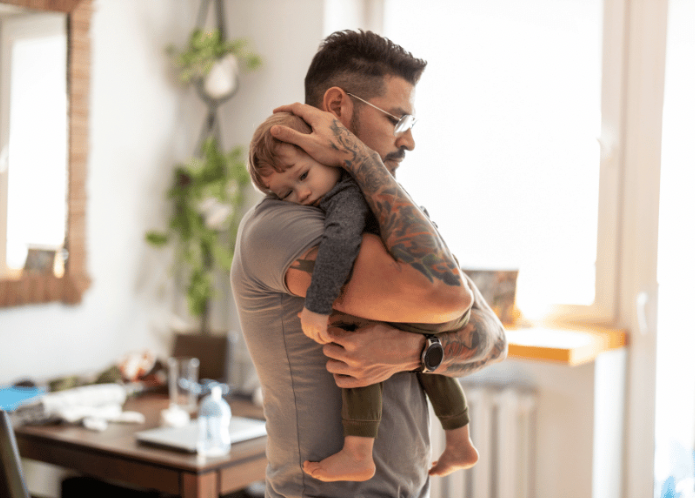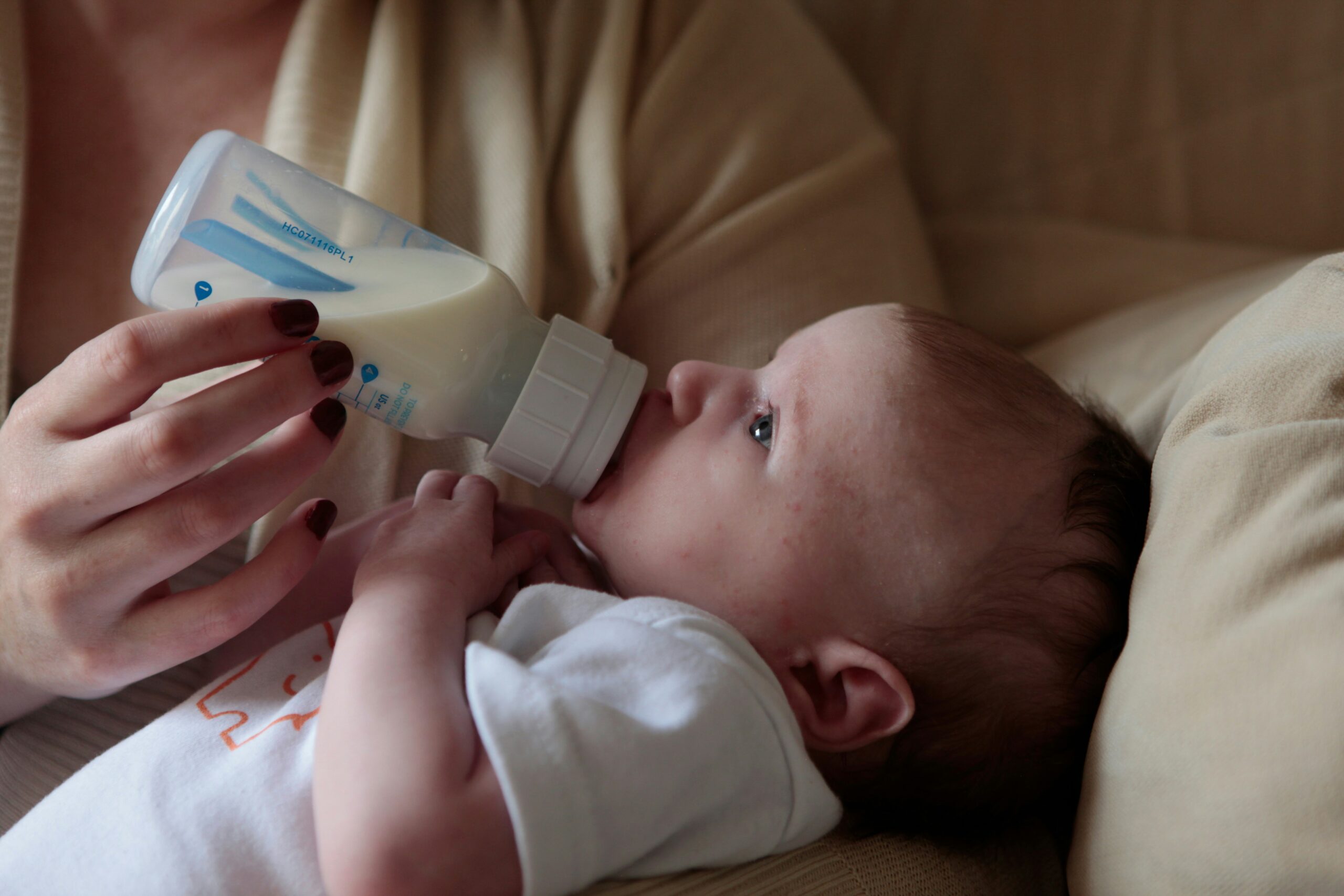Sleep disruption is also one of the most challenging changes parents face. So, why is an infant’s sleep so dysregulated? And how can you help?
You can’t have a newborn and NOT obsess about sleep.
Sleep isn’t an indulgence, it is a biological necessity for parents and children.
For children, the American Academy of Pediatrics acknowledges that sleeping the recommended number of hours is associated with improved attention, behavior, learning, memory, emotional regulation, quality of life, and mental and physical health. Regularly sleeping fewer than the number of recommended hours is associated with attention, behavior, and learning problems. Insufficient sleep also increases the risk of accidents, injuries, hypertension, obesity, diabetes, and depression. That’s some pretty convincing stuff. If you don’t believe us? Just ask the parents of any toddler and they’ll tell you that sleep impacts behavior, tantrums, learning and listening in a VERY real way.
Sleep disruption is also one of the most challenging changes parents face.
Research has found that, on average, parents’ sleep quality doesn’t recover to pre-pregnancy levels until their kids are six years old! For parents, sleep deprivation can reduce sensitive and responsive parenting behaviors, increase stress levels, and impact self-regulation skills. Poor sleep is also linked to postpartum anxiety and depression in both mothers and fathers.
So, why is an infant’s sleep so dysregulated?
One problem is related to their circadian rhythm. Circadian rhythm is our body’s internal clock that synchronizes with a 24 hour day and uses sunlight to assist in melatonin production at night and cortisol during the day. (Jet lag is an example of a disruption in circadian rhythm). Newborns haven’t developed their circadian rhythm yet! They depended on yours in the womb, and now it will take months for them to develop theirs. While they adjust, and as you may have already discovered, day/night confusion is best managed by distinguishing between daytime and nighttime with lights, sounds and stimulation. Keep feedings and play time during the day full of light and sound, and keep nighttime feedings, diaper changes and any soothing quiet and dark.
I can’t even tell the difference between my baby’s wake and sleep times!
It can be VERY hard to understand baby sleep, and their states of awareness. That’s because babies repeatedly cycle through these states each day, and the speed between states varies between babies. Unlike adults who have light sleep states, then REM cycle and then back to light, every 90-100 minutes, a baby’s active sleep cycles last approximately 20 minutes and can involve extensive infant movement (like twitching, flailing, wiggling, stretching, grunting, grimacing or crying). This is related to both a baby’s immature nervous system, and the fact that babies do not have the sleep paralysis that REM sleep offers to adults at birth. Usually, babies move between states without help (this is self-regulation) but it is especially COMMON for very young babies to struggle to self-regulate (aka manage the intensity of emotions) – that’s where you can help.
What are the Six States of Awareness?
1. Crying: intended to cause stress response in another person (you) and to prompt them to act quickly to meet needs
2. Active alert: baby is squirming, fussy, kicking or turning away when someone tries to engage
3. Quiet alert: happy, relaxed, eager to engage. Ideal time for your baby to take in new information.
4. Drowsy: time when they move from alert to sleep. Shown by disinterest in something, yawn, closed eyes, rub of face, or stare into space. This is otherwise known as “help baby transition to sleep now” before the irritable state begins.
5. Active sleep: 75% of sleep time is active sleep (for babies). Important for brain development. Looks like: shallow/rapid breathing, eye fluttering, twitching. Possibly sensitive to noise and may wake easily. During active sleep, it is easy to mistakenly think your baby is awake and go to them accidentally.
6. Deep sleep: steady/deep breathing, peaceful/relaxed stillness, baby is hard to wake.
What’s with all those reflexes? Involuntary reflexes are completely normal, and a sign of a not-yet-done nervous system. Myelin – the insulating layer around nerves that allows integration and coordination – hasn’t yet developed in infants!
Common Reflexes You’ll See:
The moro reflex (also known as the startle reflex). Your baby will spasm and throw out their arms in a startled expression as if falling.
The fencing reflex. Your baby may turn their head to one side, and the arm on that side thrusts out while the leg on that side flexes. This may make it seem like your baby can’t turn their head back to look at you.
The grasping reflex (also known as the Palmer hand grasp). Your baby will grasp a finger or object placed into their hand.
The stepping reflex. When you support your baby under the arms and they make a stepping motion with their feet on a surface.
How can you help?
Swaddling is one way you can help your baby to manage the discomfort of their primitive reflexes. Keeping your baby swaddled often throughout these first 2 months can recreate the feeling of the womb, and help them to feel calm and regulated. Swaddle fit, however, is VERY important. Most providers and the American Academy of Pediatrics recommend you make sure the swaddle allows your baby enough room to move their legs and knees up and down, and that you remove the swaddle at 3 months.
Here is a great video on how to swaddle from our friends at the Mount Sinai Parenting Center. The type of swaddle you choose is up to you. Some prefer velcro fits, others go for a lighter material. What’s most important is that the swaddle is secure (loose swaddles can pose danger to your baby when unsupervised) and that it is something light enough to keep your baby from becoming too warm.
Many new parents find it helpful to use a sleep tracking app. These can take tracking wake windows off your mental to-do list, helping you know when to put your baby down for a nap and how to adjust bedtime as needed according to your baby’s sleep patterns. One great one is the Smart Sleep Coach by Pampers.
A few other safety tips for newborn sleep (this is NOT a complete list, so check out the American Academy of Pediatrics for more recommendations).
1. Always put your baby on their backs to sleep. EVERY time. This includes nap and night sleep, and even if you are watching. (note: you can start tummy time to balance this time spent on their backs)
2. An empty crib is a safe crib. Use a safety approved mattress, a fitted sheet, and nothing else. No blankets, pillows, positioners, toys or bumpers.
3. Consider offering a clean, dry, pacifier to your baby in their crib. Pacifier use has been shown to increase the risk of Sudden Infant Death Syndrome.
4. Try to avoid having your baby get too hot during sleep. Keep the room at a comfortable temperature, ideally between 68-72 degrees, and use light pajamas and swaddles.
5. Always supervise your baby when they are asleep in any device like a car seat, bouncer or swing. Those are NOT recommended for unattended use, and require adult supervision at all times.
Amidst all the sleep deprivation, chaotic schedules and trying moments, remember that you and your newborn are learning together. Be patient with yourself, sleep is a process and it’s evolving. Remember that it won’t be quite so challenging forever, and that the more you can do to establish good routines off the bat, the better.
This post originally appeared on YourCooper.com, your go-to for live, interactive parent coaching and curated group sessions. For discounts and member exclusives on Cooper, visit our Shop and Parent Log-In pages.



